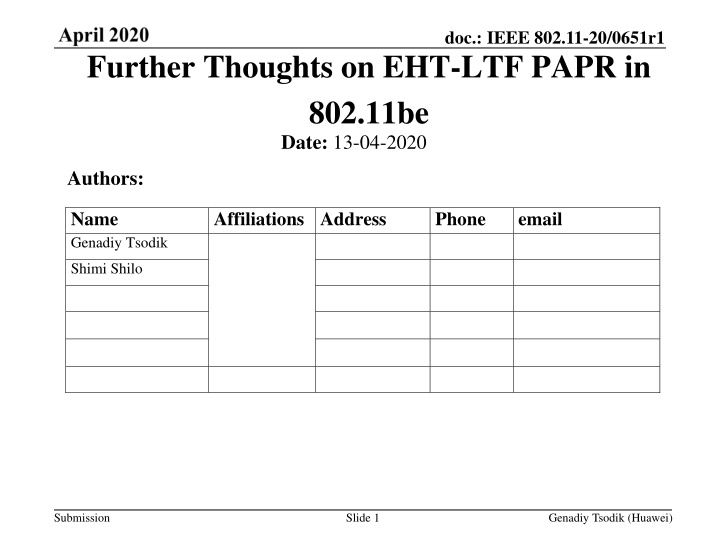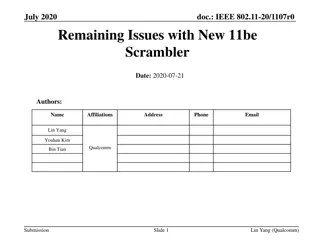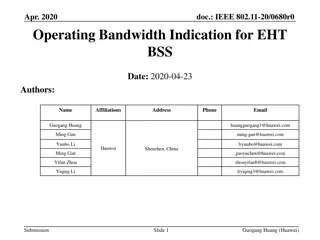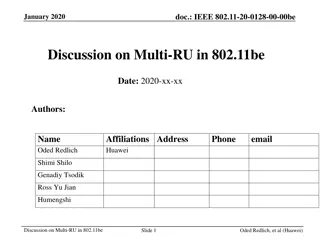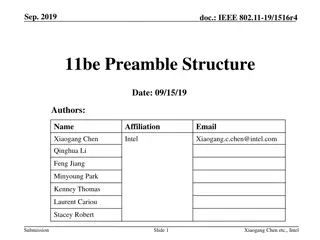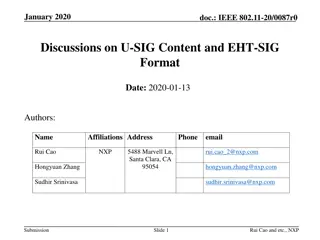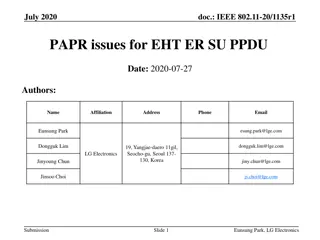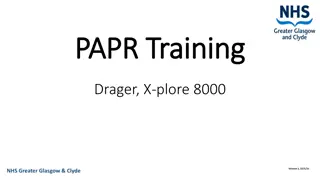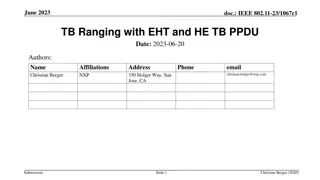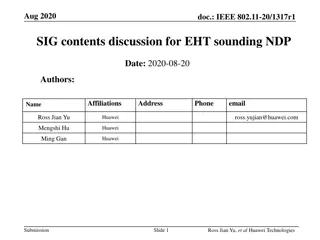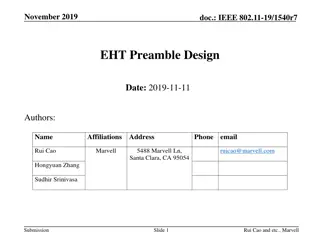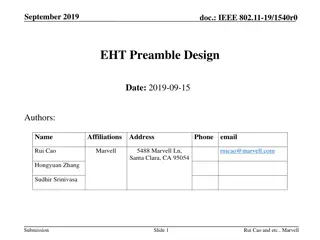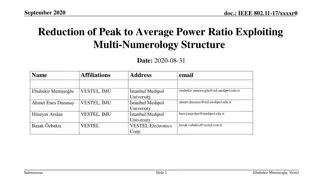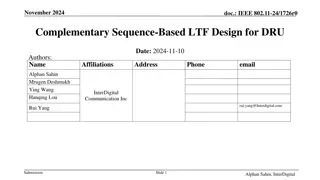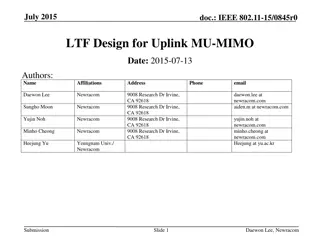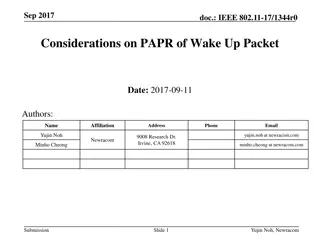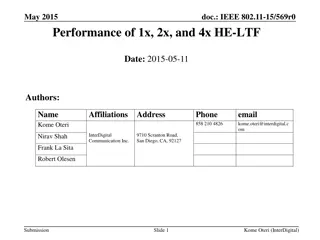Further Thoughts on EHT-LTF PAPR in 802.11be
The paper delves into the PAPR aspect of EHT-LTF in 802.11be, focusing on scenarios beyond Multi-RU cases. It discusses the impact on PAPR, potential solutions, and the necessity of minimizing PAPR in various scenarios. Detailed technical insights and solutions are presented to address the challenges associated with PAPR. The study highlights the complexities of minimizing PAPR and proposes novel approaches to optimize signal quality.
Download Presentation

Please find below an Image/Link to download the presentation.
The content on the website is provided AS IS for your information and personal use only. It may not be sold, licensed, or shared on other websites without obtaining consent from the author.If you encounter any issues during the download, it is possible that the publisher has removed the file from their server.
You are allowed to download the files provided on this website for personal or commercial use, subject to the condition that they are used lawfully. All files are the property of their respective owners.
The content on the website is provided AS IS for your information and personal use only. It may not be sold, licensed, or shared on other websites without obtaining consent from the author.
E N D
Presentation Transcript
doc.: IEEE 802.11-20/0651r1 Further Thoughts on EHT-LTF PAPR in 802.11be Date: 13-04-2020 Authors: Name Genadiy Tsodik Affiliations Address Phone email Shimi Shilo Submission Slide 1 Genadiy Tsodik (Huawei)
doc.: IEEE 802.11-20/0651r1 Introduction The PAPR topic was discussed in several 11be contributions, some of which were focused on puncturing cases and solutions for the entire BW [1], [2] In [3] we examined the PAPR aspect of EHT-LTF field in cases of an MRU and compared between several solutions that minimize the PAPR Following the discussions that took place during the presentation of [3] we would like to provide clarifications and also to extend the discussion on PAPR aspects for additional scenarios (not only Multi-RU) We recap here the main technical details that were discussed in [3] and also add a more extended view of the PAPR problem In this contribution we suggest a solution that may be applied on top of EHT-LTF sequence to minimize PAPR in specific scenarios (the results are based on EHT-LTF produced by reusing HE-LTF for BW 160MHz) Submission Slide 2 Genadiy Tsodik (Huawei)
doc.: IEEE 802.11-20/0651r1 Recap Main Issues In [3] we studied MRU scenarios, where the transmitted signal contains multiple frequency segments, and showed that there is an impact on the PAPR of EHT-LTF in some cases We also compared between PAPR of EHT-LTF field and data portion and showed that the gap between data portion and EHT-LTF field is smaller than it is in 11ax cases We showed that such smaller gap may cause PER degradation (we applied the RAPP model for PA nonlinearity) During the review of potential solutions, we highlighted the issue that a single (or small number of) EHT-LTF sequence cannot yield minimization of PAPR in all MRU cases due to an abundance of scenarios and combinations We suggested to apply a linear phase with constant phase offset where the phase values are selected per scenario (e.g. MRU combination) Time Submission Slide 3 Genadiy Tsodik (Huawei)
doc.: IEEE 802.11-20/0651r1 Recap - Impact on PAPR We showed that there is an impact on PAPR of EHT-LTF up to 2.5-3dB in most of the scenarios This increase can be explained by a superposition of multiple waveforms which increase the probability of higher peaks to be created Submission Slide 4
doc.: IEEE 802.11-20/0651r1 Recap Impact of PAPR on Performance We also showed the impact on data portion PAPR (less than 0.5dB) is smaller than on EHT-LTF field, thus back-off may be mandated by EHT-LTF ~2dB ~0.3dB We further explained that the higher PAPR associated with the EHT-LTF sequences of an MRU impacts the channel estimation and hence the demodulation performance Hence, we showed the impact of higher MRU EHT-LTF PAPR on the PER by simulating the same scenarios with random sequences with different PAPR based on RAPP model of PA nonlinearity Submission Slide 5
doc.: IEEE 802.11-20/0651r1 Recap Solutions Survey We examined several solution for PAPR reduction, including new EHT-LTF sequence design, extension of 11ax phase rotation and the proposed new method of linear phase with phase offset The results revealed that new sequences (designed per MRU) and the proposed method of linear phase with phase offset may minimize PAPR for most of the examined scenarios 242+484 Comb Single RU484 MRU PAPR New Sequence Constant Phase Linear Phase Linear Phase + Offset 2/2 5.86 7.03 6.29 6.96 6.95 6.71 1/2 5.86 7.93 6.68 7.42 6.95 6.85 4/1 5.86 7.65 6.68 7.65 6.87 6.82 3/1 5.86 7.8 6.28 7.23 7.16 6.9 Submission Slide 6 Genadiy Tsodik (Huawei)
doc.: IEEE 802.11-20/0651r1 Recap Summary Finally we summarized the reviewed solutions and compared them in terms of PAPR reduction and also design and implementation aspects The main conclusion was that finding a single/unified solution that can minimize all the combinations is not practical, whereas the proposed method of linear phase with phase offset may resolve the trade-off between design complexity and PAPR minimization Design/Spec Complexity Backward Compatibility Solution PAPR Reduction Implementation Complexity High - A lot of sequences to define High - large memory required New Sequnce Design High None Reuse 11ax Phase Rotation Constant Phase Rotation Very low None None Full Full (by setting phase to zero) Full (by setting phase to zero) Full (by setting phase to zero) Low Medium Low Linear Phase Medium Meidum Low Linear Phase with Phase Offset High Medium Low Submission Slide 7 Genadiy Tsodik (Huawei)
doc.: IEEE 802.11-20/0651r1 Extension for Phase Continuity As raised during the presentation of [3], we would like to ensure phase continuity over the allocated tones in relevant MRU combinations Thus we rechecked the case of 52+26 MRU where the two aggregated RUs are contiguous in frequency We added a restriction on Linear Phase to be continuous on the edges of the two RUs (we actually restricted our solution to zero phase at the intersection) We can see in the figure on the right that in all the simulated MRU combinations the gap between general linear phase and linear phase with phase continuity restriction is negligible Linear Phase 52RU 26RU Frequency Submission Slide 8 Genadiy Tsodik (Huawei)
doc.: IEEE 802.11-20/0651r1 Extension of the Topic to More Scenarios During the discussions of [3], it was mentioned that the high PAPR issue is not unique for MRU scenarios but can be relevant for additional scenarios supported in 11be (e.g. preamble puncturing) As this is indeed true, we extend the relevant scenarios for high EHT-LTF PAPR to include the following: Punctured non-OFDMA transmission (in both DL & UL) Multi-RU OFDMA transmission in the UL Punctured NDP transmission The main metrics for PAPR minimization in a specific scenario is the difference between PAPR on data portion and PAPR on EHT-LTF, and PER degradation Submission Slide 9
doc.: IEEE 802.11-20/0651r1 Detailed Analysis In order to decide which combinations are relevant and require PAPR minimization we examined the impact of PAPR on PER in different scenarios for BW 80MHz The example on the right shows that in specific case of 242+484 we can improve PER by reducing PAPR from 7.9dB to 6.8dB According to our simulations ~25% of total combinations may require PAPR reduction BW(MHz) Combinations (Total) # of Problematic Combinations 20 40 1 (4) 1 (8) 52(2)+26(2) 52(6)+26(11) 52(6)+26(11) 52(7)+26(17) 242(1)+484(2) 242(4)+484(1) 80 (small RUs) 2(4) 80 (Large RUs) 2(4) > 80 TBD Submission Slide 10
doc.: IEEE 802.11-20/0651r1 General Solution for PAPR Issue Following the two previous slides we can say that the majority of the MRU combinations (BW 80MHz) have small or negligible PER degradation with reused HE-LTF sequences, however few MRUs do need to be handled Hence we propose the following approach for PAPR reduction of EHT-LTF: Apply on top of EHT-LTF sequence a PAPR reduction solution for specific scenarios We the suggested in [3] a linear phase with phase offset as a solution for additional PAPR reduction In this case the implementation may include an additional block that can be applied only for specific scenarios of high PAPR Lower PAPR EHT-LTF Sequence 802.11be EHT-LTF Sequence(s) EHT-LTF Freq Domain Transmission Parameters X Phases Sequence (may be 1 if no apply ) Linear Phase + Phase Offset Submission Slide 11
doc.: IEEE 802.11-20/0651r1 Conclusion PAPR is increased in multiple scenarios adopted by 802.11be and needs to be reduced in order to minimize the impact on channel estimation and PER We simulated a design that consists of EHT-LTF sequence (reused HE-LTF for BW 80MHz) and marked a specific cases where PAPR reduction is required We suggested to add a PAPR reduction solution on top of EHT-LTF sequence in marked cases We proposed solution of linear phase with phase offset which implies low implementation complexity and can be easily applied for these specific cases A proposed solution of linear phase and phase offset can be considered for PAPR minimization of EHT-STF field as well Submission Slide 12 Genadiy Tsodik (Huawei)
doc.: IEEE 802.11-20/0651r1 References [1] 11-19-1925-02-00be-consideration-of-eht-ltf [2] 11-20-0117-01-00be-eht-ltfs-design-for-wideband [3] 11-20-0473-01-00be-impact-of-multiple-ru-allocation-on-papr Submission Slide 13 Genadiy Tsodik (Huawei)
doc.: IEEE 802.11-20/0651r1 SP1 Do you support that 802.11be will define a solution which minimizes PAPR of EHT-LTF field in following scenarios? For BW 80MHz cases mentioned on slide 10 For BW > 80MHz TBD Submission Slide 14 Genadiy Tsodik (Huawei)
doc.: IEEE 802.11-20/0651r1 SP2 Do you support that 11be will define a solution, based on linear phase and phase offset, as a solution for minimizing PAPR of EHT-LTF in specific cases? For BW 80MHz cases mentioned on slide 10 For BW > 80MHz TBD Submission Slide 15 Genadiy Tsodik (Huawei)
